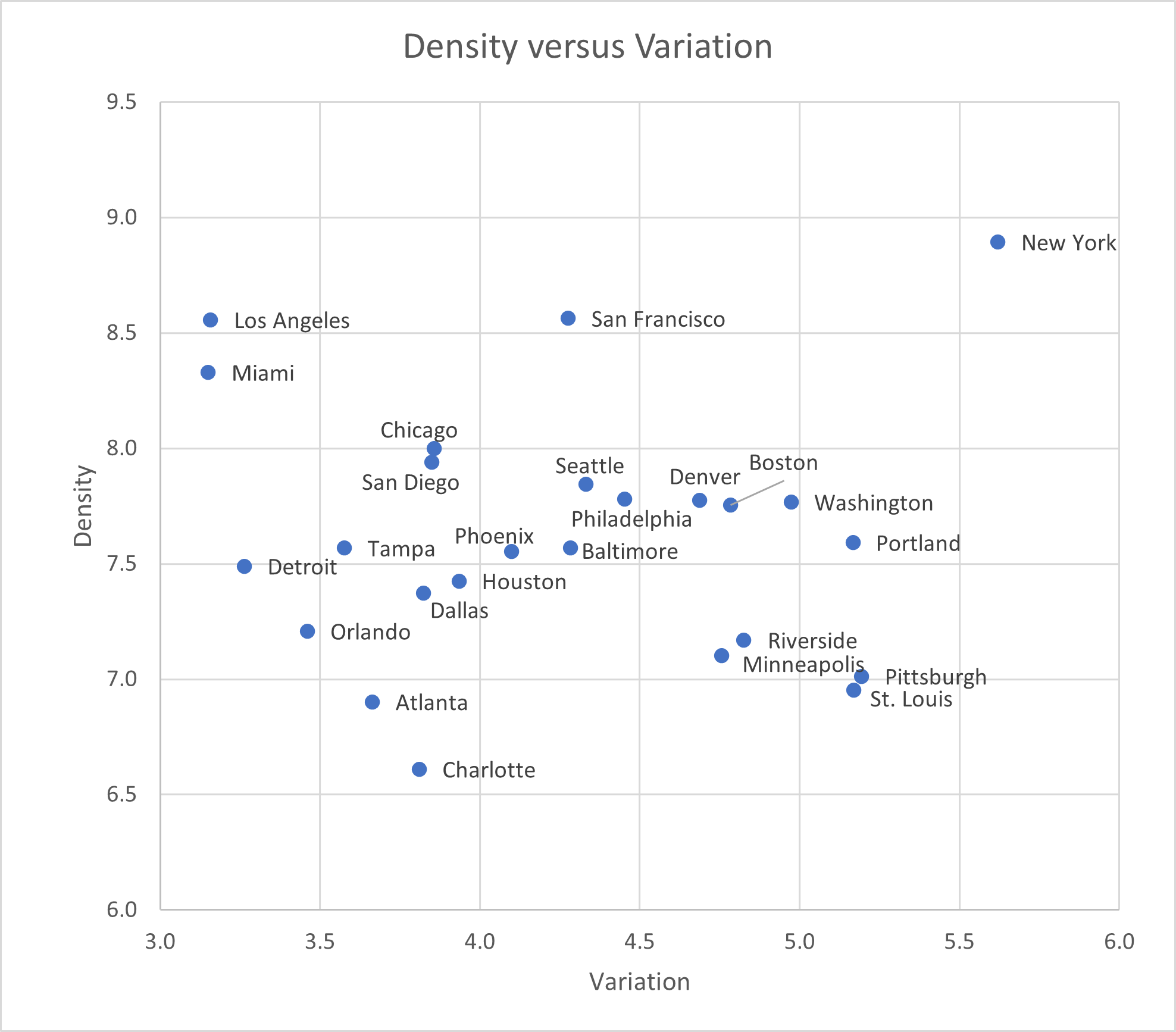Physical Address
304 North Cardinal St.
Dorchester Center, MA 02124
Physical Address
304 North Cardinal St.
Dorchester Center, MA 02124

Urbanist and YIMBY Twitter had a field day dunking on Nathan J. Robinson, whose essay in his publication Current Affairs called for building new cities in California. But California really could use some new cities - and we need to think about them in primarily economic terms.

A trip to Houston reveals how a city can design without shame, urbanize around cars, and achieve privacy in a context of radical integration.
The narrow choice of city versus suburb is a balance of cost and amenities. But the bigger question – in which region should I make my home? – requires one to look on a higher plane.

A quick data exercise shows that LA really is unique among big American metros, matched only by its East Coast twin, Miami.

Case studies from several authors help explain the gritty politics of "Yes." The list includes three classics and will be expanded with reader submissions.
In July, I showed that an otherwise careful group of researchers at the Othering and Belonging Institute were using a measure of statistical racial segregation that confounds diversity with segregation. Briefly, regions with more variety in the racial makeup of their neighborhoods will show up as statistically “segregated.” Regions where all neighborhoods are pretty similar will show up as statistically “integrated.” To their credit, the study authors corresponded with me at length and adjusted their Technical Appendix to emphasize limitations that I had pointed out. Today, Mark Zandi, Dante DeAntonio, Kwame Donaldson, and Matt Colyar of Moody’s Analytics released a much less careful study purporting to show the “macroeconomic benefits of racial integration.” But if one were to make the mistake of taking their study at all seriously it would lead one to the opposite conclusion: mostly-white counties do better economically. They discovered white privilege and mislabeled it “integration.” (When economists talk about “segregation” statistically, they mean differences in racial proportions across neighborhoods. This is not the same as the de jure segregation regime imposed in the American South. It’s not even the de facto segregation that persists in some neighborhoods today.) The easiest way to see Zandi et al’s mistake is to work backwards from the table of county results they (helpfully) published. The most integrated county in America, in their analysis, is Kennebec County, Maine. It’s 94.6% white. The rest of the most-integrated counties are similarly pallid – with the exception of Webb County, Texas, which is 95% Hispanic. In each of these counties, integration is a mathematical product of the lack of diversity. With hardly any minorities, hardly any neighborhood can diverge from the dominant group. These extreme counties aren’t an accident. Whereas most researchers treat metropolitan areas together, Zandi’s team worked with counties. Several of their […]

Hayek says that planning is the road to serfdom. Holland may be the most thoroughly planned country on earth - and it's delightful. How does a market urbanist respond to excellent planning?

In the standard urban growth model, a circular city lies in a featureless agricultural plain. When the price of land at the edge of the city rises above the value of agricultural land, “land conversion” occurs. In the real world, we’re more likely to call it “development” and it is, of course, a lot more complicated. Simplification is valuable and gives us more general insights. But is greenfield development complicated in ways that are interesting and might change the results of urban economic models? Or that might change the ways we think or talk about development policy? Witold Rybczynski’s 2007 book Last Harvest helps answer these questions. It tracks a specific cornfield in Londonderry, Pennsylvania, from the retirement of the last farmer to the moving boxes of the first resident. With its zoomed-in lens, Last Harvest answers (or at least raises) lots of questions that are interesting but not especially important in the grand scheme: Why do expensive homes mix some top-line finishes with cheap, plasticky ones? Why do anti-development communities permit any subdivisions at all? What is ‘community sewerage,’ and how does it work? Exactly who thinks it’s attractive to have brick and vinyl cladding on the same house? What’s it like to buy a house from a national homebuilder? Does Chester County really produce forty percent of America’s mushrooms? The Stack Rybczynski does not use this term, but what he describes is part of what I call the “stack” of housing supply. One of the central facts of development is that it relies on a very long chain of industries and professions, each of which relies on every other part of the stack doing its job. If one part is left undone, nobody gets paid: ‘Without a water contract, we can’t get a permit for the water mains, […]
Headlines last month proclaimed that “Cities Have Grown More Diverse, And More Segregated, Since the 90s.” The headlines originate in the key findings of a new, detailed study from the Othering and Belonging Institute (OBI) at UC Berkeley. The study leans heavily on a relatively new metric – the Divergence Index – which has impressed many researchers (myself included) with its versatility. But now that we have seen the Divergence Index in action, its versatility clearly comes at a cost: the Divergence Index conflates what we would intuitively call diversity with “segregation.” As a result, more-diverse metro areas are usually ranked as more segregated by the Divergence Index. And as America became far more diverse over the past 30 years, it is logical that the Divergence Index would rise in most metro areas. Why is it so hard to measure segregation? Racial segregation is easy to see. You walk down the street and almost everybody in one neighborhood looks different than you and almost everybody in another neighborhood looks the same as you. The human eye and ear can also distinguish categories that are meaningful in some contexts but not others. Everybody but me in the café where I watched European soccer last week appeared to be not only Black but specifically Ethiopian. Was that café integrated or segregated? I certainly felt welcome as I bantered at the bar with an Ethiopian-American tennis instructor. But statistically, the café was far more Black and vastly more Ethiopian than the D.C. region as a whole. In this context, “segregation” refers to places where one group is overrepresented – like the café – not to the legal regime that imposed second-class citizenship and pervaded every aspect of life for black Americans. Given the word’s loaded history, it would have been wiser for social […]
The best book on zoning and NIMBYism you’ve never read might well be The Housing Bias by Paul Boudreaux. The author is a law professor, but you’d be forgiven for thinking he’s a journalist. His writing is engaging – and occasionally funny – and he does what is unthinkable for many scholars: drives to various places to interview people who are engaged in the (legal) drama of what we now call “the housing crisis.” Boudreaux had the misfortune of being ahead of his time. The housing market was so soft in 2011 that his book landed with nary a sound. A quick web search turned up no book reviews besides the publisher’s blurbs. The book (and you’ll be forgiven if you stop reading right here) will set you back. That’s unfortunate. Just a few years later, the book would have connected with passions shared by the rapidly growing YIMBY movement and a publisher would have marketed it to the masses. Boudreaux’s thesis is that “the laws that govern our use of land are biased in favor of one specific group of Americans—affluent, home-owning families—who least need the government’s help.” He keeps his ideological cards close to the vest. But that’s the point: one need not lean left or right to want to stop using the power of the state to comfort the comfortable and afflict the afflicted. The first chapter is the most important, because it lays out the foundation for all that local governments do, good and bad, in land use: the police power. He’s writing from Manassas, Virginia, where “restaurants with Aztec pyramids on them” telegraph the large Hispanic immigrant community. A vocal minority opposed this local immigration, and pressured local governments to stop it. Of course, the city doesn’t issue passports, but the police power allows local […]